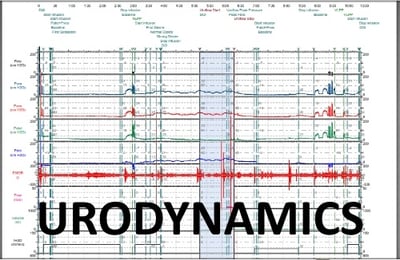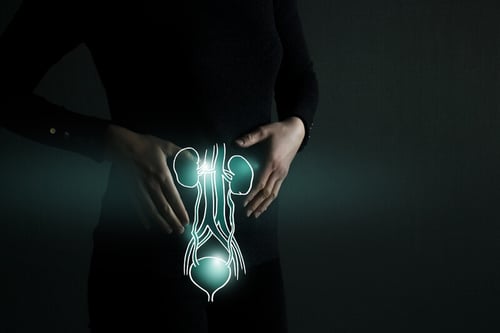 The lower urinary tract does quite a lot. Urodynamics testing gives your urologist, urogynecologist, or physician the insights needed to understand how your urinary system functions — and whether you might need treatment.
The lower urinary tract does quite a lot. Urodynamics testing gives your urologist, urogynecologist, or physician the insights needed to understand how your urinary system functions — and whether you might need treatment.
As you might expect, assessing the performance of the bladder, urethra, and associated muscles is no walk in the park. Here's how urodynamics testing provides valuable information about the underlying causes of urinary problems, such as incontinence, frequent urination, or difficulty emptying the bladder.
What Is Urodynamics Testing?
Urodynamics testing is a term for a group of highly specialized diagnostic procedures. As the suffix "-dynamic" implies, it focuses on temporary physiological conditions associated with activity. In other words, we're talking about measuring the pressure, volume, and flow rate changes that take place as fluids pass through the lower urinary tract.
Why Urodynamics Testing Matters
Urodynamics testing doesn't just benefit individual patients. It's an essential part of medical science, particularly in urology.
Urodynamics procedures help clinicians diagnose and manage various urinary tract disorders. By actively assessing the function and coordination of the urinary system, these tests provide valuable information that aids in accurate diagnoses and appropriate treatment planning. Urodynamic investigations have played a role in everything from evaluating postoperative lower urinary tract disorders to managing patients with failed surgeries or neurological issues.
The Need for Urodynamics Testing
Urodynamics testing promotes proactive patient healthcare. By equipping caregivers with advanced knowledge, these procedures help them diagnose the underlying causes of urinary issues. For instance, primary caregivers may request urodynamics testing for men and women who have trouble voiding, incontinent individuals, cervical cancer survivors who’ve gone through radical hysterectomies, and children with severe or therapy-resistant urinary tract abnormalities.
Developing an appropriate treatment plan is next to impossible when clinicians don't understand the root cause of a patient's symptoms. In many cases, performing the incorrect procedure makes things worse. Urodynamics testing lets physicians choose treatments with the highest likelihood of positive outcomes — whether that means medication, behavioral therapies, or surgical interventions.
Do you need urodynamics within your hospital or medical practice? If so, find out more about BHN's urodynamics testing services that can help you get going with urodynamics with no upfront investment in equipment or training. Click the button below to learn more.
The Science Behind Urodynamics Testing
There are two major scientific principles to keep in mind when thinking about urodynamics: fluid dynamics and neuromuscular function.
For those who haven't taken a physics class in a while, fluid dynamics describes how fluids behave in motion or at rest. In the process, it accounts for factors like viscosity, density, pressure, and volume.
Neuromuscular function refers to the complex interactions between the nervous system and muscles, producing coordinated movement and force. It also describes the sensory feedback that lets sphincter muscles send information about their activities and position to the central nervous system.
Urodynamics testing helps put all these factors together in a sensible way. Think of it like the missing link between a patient with lower urinary tract symptoms and the step-by-step mechanisms that led up to the problem.
Types of Urodynamics Testing
Most urodynamics testing takes place in specialized clinics or hospitals following a physician’s referral. Every case is unique, but a few common procedures include:
Complex Uroflowmetry
This test measures the rate and volume of urine flow by having you urinate into a funnel. An electronic device attached to the funnel measures how many milliliters of urine you pass per second, computing peak flow rates as well as averages over time.
Cystometry
Also known as a cystometrogram (or CMG), a cystometry test assesses bladder capacity and the sensation of filling and emptying the bladder. You'll usually have to empty your bladder before testing.
To get started, a clinician will insert one soft catheter into your urethra and another into your rectum.
This two-catheter setup measures the pressure inside and outside your bladder along with fluid levels. Having these two measurements allows for calculating a differential pressure, which is very helpful in understand lower urinary track issues.
Then, the clinician will fill your bladder with a sterile liquid dyed for X-ray analysis and ask you to describe how you feel. You may also be asked to cough or strain. These tests can help diagnose leaks, inappropriate bladder contractions, and how much pressure builds up before you feel urinary urges.

Pressure Flow Studies
Pressure flow studies judge how much pressure your bladder requires to urinate properly and how much urine flows as a result. They typically occur at the end of cystometry exams —when you feel your bladder is full and urinate into a toilet that measures the flow.
Pressure flow studies help identify bladder blockages. This makes them essential diagnostic aids for helping enlarged prostate sufferers, vaginal wall prolapse patients, and recipients of urinary incontinence surgeries.
Electromyography (EMG)
EMG tests check how well your muscles are working and whether the nerves that control them are sending the proper signals. In urodynamics, EMGs are used to measure the pelvic floor, sphincter, and bladder muscles.
During urodynamics EMG tests, a clinician places a series of sensors on your skin close to the rectum and urethra. Alternatively, they may use an internal catheter. By observing when the nerves fire and the muscles contract, clinicians can diagnose coordination issues, nerve damage, and other problems.
The Process of Urodynamics Testing
Urodynamics testing is generally straightforward. Patients rarely have to undergo special preparations but may have to adjust their medication regimens or fluid intake. In some cases, clinicians ask you to arrive with a full bladder. If you've previously had recurrent urinary tract infections, you may have to complete a course of antibiotics for safety reasons.
Most urodynamics tests take under an hour. Some patients may feel a slight discomfort while urinating afterward, but they can typically gain relief by drinking water, taking a warm bath, or applying heat. Patients should self-monitor for signs of infection.
Interpreting the Results of Urodynamics Testing
One neat thing about urodynamics testing is that it produces results so quickly. With cystometry and uroflowmetry, clinicians may discuss their findings with patients on the spot. Other tests might only take a few days depending on their complexity.
This speed doesn't mean interpretation is simple: Clinicians must consider not only patient conditions but also the type of testing devices used, such as air-charged or fluid-filled catheters. Proper interpretation requires in-depth training and familiarity with the equipment.
Conclusion
Urodynamics testing is vital for properly diagnosing and treating urological conditions:
It boosts diagnostic accuracy by revealing bladder function, urethral resistance, and muscle coordination in real time.
It aids in identifying the underlying causes of urinary problems like incontinence, frequent urination, or difficulty emptying the bladder.
It gives healthcare providers the insights required to develop personalized treatment plans based on each individual's specific condition.
It improves the surgical decision-making process by clarifying patient selection and procedure planning.
Think you might benefit from urodynamics testing? Reaching out to your healthcare provider for more information is the first step. Your clinician can assess your specific symptoms, analyze your medical history, and guide you through the process.
FAQ: Frequently Asked Questions About Urodynamics Testing
Q: What does urodynamics testing involve?
A: Urodynamics testing assesses how well the bladder, urethra, and associated muscles are functioning. Your tests may include uroflowmetry, cystometry, pressure flow studies, or electromyography (EMG).
Q: Is urodynamics testing painful?
A: Some individuals may experience minor discomfort during certain parts of the procedure. Local anesthesia is usually available.
Q: How long does urodynamics testing take?
A: Most procedures take about 30 minutes to an hour to complete. This varies depending on the specific tests being performed and individual factors.
Q: Can I resume normal activities after urodynamics testing?
A: Most individuals can resume their normal activities soon after urodynamics testing. Be sure to follow your provider's instructions, such as avoiding heavy lifting or strenuous exercise for a short period following the test.


